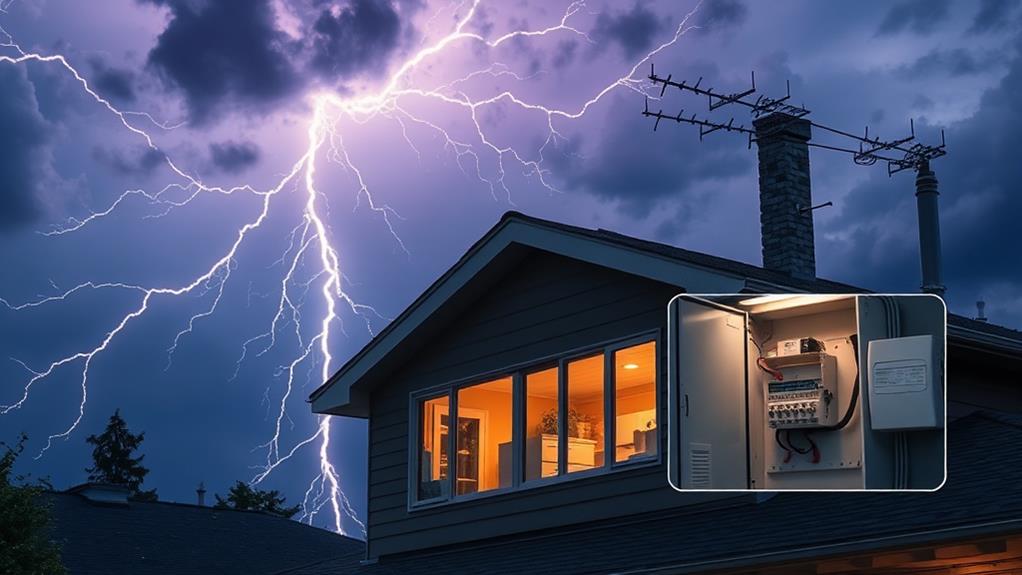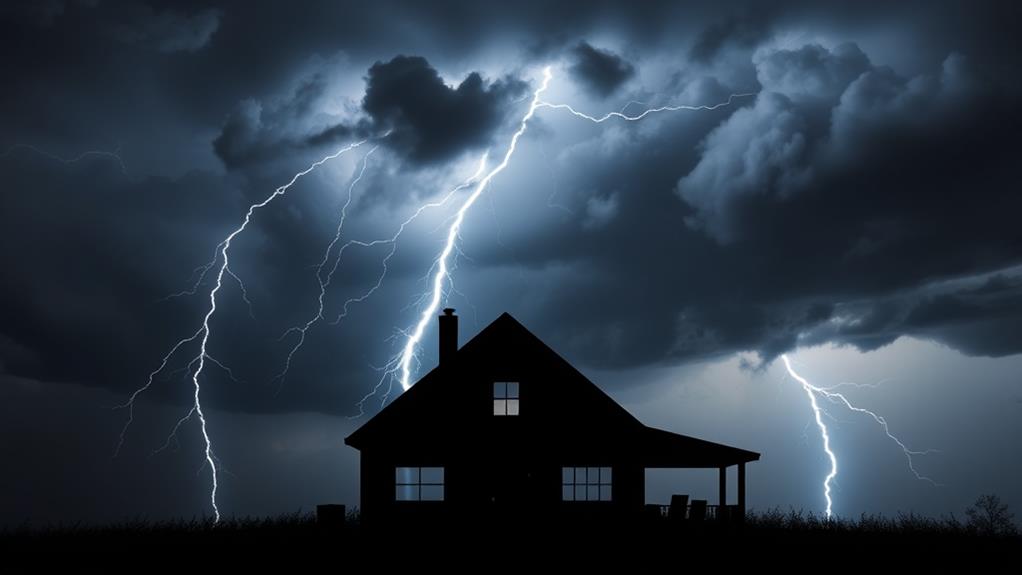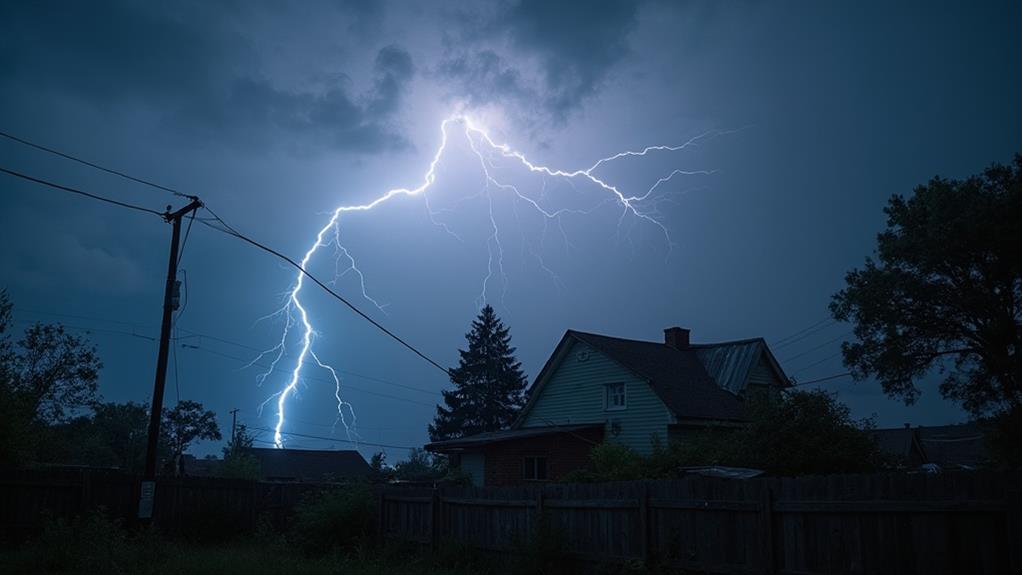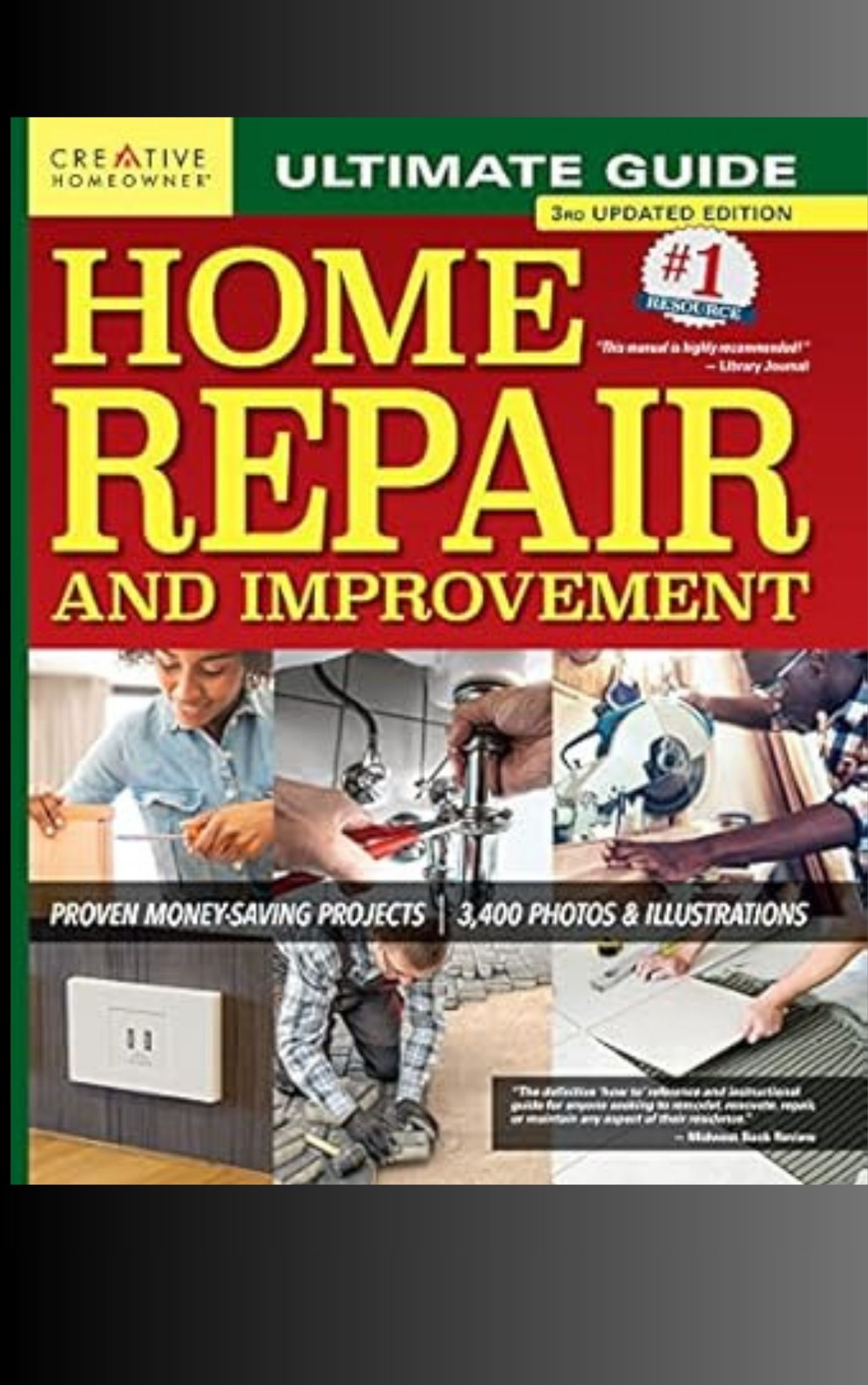Lightning strikes can severely damage homes, threatening electrical systems, utilities, and structural components. To protect your property, implement comprehensive surge protection strategies, including whole-house surge devices and point-of-use protectors. Install properly grounded lightning rods and a network of conductors to safely dissipate electrical charges. Regularly inspect and maintain your home's electrical system, focusing on adequate grounding and updated wiring. Review your homeowners insurance policy to ensure coverage for lightning-related damages. Take precautionary measures during storms, such as unplugging sensitive electronics. By understanding lightning's impact and adopting these protective measures, you can significantly reduce the risk to your home and belongings.
Understanding Lightning's Impact

Lightning, a powerful and awe-inspiring natural phenomenon, poses significant risks to residential structures and utilities. When a lightning strike occurs, it can generate up to 300 million volts of electricity and reach temperatures of 50,000°F. This immense energy seeks the path of least resistance to the ground, often traveling through a building's electrical system, plumbing, or structural components.
The impact of lightning on homes can be devastating. Direct strikes can cause fires, structural damage, and destruction of electronic equipment. Even nearby strikes can induce power surges that damage sensitive electronics and appliances. Lightning can also create electromagnetic pulses that interfere with communication systems and disrupt power distribution networks.
Understanding the behavior of lightning is crucial for implementing effective protection measures. Lightning typically strikes the highest points in an area, making tall structures particularly vulnerable. It can also travel horizontally for long distances before striking the ground, potentially affecting homes that are not directly beneath storm clouds. By recognizing these patterns and the potential consequences of lightning strikes, homeowners can take informed steps to safeguard their properties and minimize the risk of damage or injury.
Home Electrical System Vulnerabilities
While understanding lightning's behavior is important, it's equally vital to recognize the vulnerabilities within a home's electrical system that can exacerbate the effects of a strike. A home's electrical infrastructure is particularly susceptible to lightning-induced surges and transients. These sudden voltage spikes can overwhelm standard household circuits, damaging or destroying connected appliances and electronics.
Key vulnerabilities include inadequate grounding systems, outdated wiring, and lack of surge protection devices. Improper grounding can create dangerous paths for lightning current, potentially causing fires or electrocution hazards. Older wiring may not meet current safety standards and can be more prone to failure during a surge event. Without properly installed surge protectors, sensitive electronic equipment remains exposed to potentially destructive voltage fluctuations.
The service entrance, where utility power enters the home, is a critical point of vulnerability. Lightning strikes to nearby power lines can travel through this connection, affecting the entire household electrical system. Additionally, any metal pipes or conduits entering the home can serve as conduits for lightning current, creating secondary points of entry for damaging surges. Addressing these vulnerabilities is essential for comprehensive lightning protection.
Surge Protection Strategies

To effectively safeguard a home against lightning-induced surges, implementing a comprehensive surge protection strategy is crucial. This multi-layered approach begins with whole-house surge protection devices installed at the main electrical panel. These devices intercept and divert large surges before they enter the home's wiring system.
The next level of protection involves point-of-use surge protectors for individual electronic devices and appliances. These units provide an additional defense against residual surges that may bypass the main surge protector. It's essential to choose surge protectors with appropriate joule ratings and response times for optimal protection.
Grounding is a critical component of any surge protection strategy. Ensure that the home's electrical system is properly grounded, and consider installing additional grounding rods if necessary. Proper grounding helps dissipate excess electrical energy safely into the earth.
Regularly inspect and maintain surge protection devices, replacing them after significant surge events or according to manufacturer recommendations. Additionally, consider upgrading older wiring systems and installing dedicated circuits for sensitive electronics. Implementing these strategies can significantly reduce the risk of damage from lightning-induced surges and other electrical disturbances.
Lightning Rods and Grounding
Beyond surge protection, a key element in safeguarding homes from lightning strikes is the installation of lightning rods and proper grounding systems. These components work together to provide a safe path for lightning to follow, redirecting it away from the structure and into the ground.
Lightning rods, typically made of copper or aluminum, are installed at the highest points of a building. They act as attractive targets for lightning, intercepting strikes before they can damage the roof or other vulnerable areas. A network of conductors connects these rods to ground rods, which are driven deep into the earth.
The grounding system is crucial for dissipating the enormous electrical charge from a lightning strike. It consists of copper or aluminum wires that run from the lightning rods to ground rods or plates buried in the soil. This setup ensures that the electrical current is safely dispersed into the earth, minimizing the risk of fire or structural damage.
Professional installation is essential for an effective lightning protection system. Certified technicians can assess your home's specific needs, design an appropriate layout, and ensure proper bonding to other metallic systems, maximizing safety and efficiency.
Insurance and Safety Measures

Insurance plays a crucial role in protecting homeowners from financial losses due to utility and structural damage. Most standard homeowners insurance policies cover lightning-related damages, including fires, power surges, and structural harm. However, it's essential to review your policy carefully to understand the extent of coverage and any exclusions.
To enhance safety and reduce the risk of lightning-related incidents, implement additional measures beyond insurance. Install surge protectors on all major appliances and electronic devices to safeguard against power surges. Unplug sensitive equipment during storms when possible. Regularly maintain your home's electrical system, ensuring proper grounding and updating outdated wiring.
Create an emergency plan for your family, including a designated safe area within the home during thunderstorms. Avoid using corded phones, plumbing fixtures, and electrical appliances during lightning events. Consider installing a whole-house surge protection system for comprehensive defense against electrical spikes. Trim trees near your home to minimize the risk of falling branches damaging utilities or structures. By combining comprehensive insurance coverage with proactive safety measures, homeowners can significantly reduce their vulnerability to lightning-related damages and ensure better protection for their property and loved ones.
Frequently Asked Questions
Can Lightning Strike the Same Place Twice?
Lightning can indeed strike the same place twice. While it's relatively uncommon, tall structures or prominent geographical features are more susceptible to repeated strikes. The misconception that lightning never strikes twice in the same location is a myth.
How Long Does a Typical Lightning Strike Last?
A typical lightning strike is incredibly brief, lasting only about 30 microseconds (0.00003 seconds). However, multiple strokes can occur within a single flash, giving the impression of a longer-lasting strike to the human eye.
What's the Difference Between Heat Lightning and Regular Lightning?
Picture a distant, silent flash illuminating the sky. This is heat lightning, essentially regular lightning occurring far away. The key difference lies in the absence of audible thunder, as the sound doesn't travel the vast distance to reach observers.
Are Rubber-Soled Shoes Effective Protection Against Lightning Strikes?
Rubber-soled shoes are not effective protection against lightning strikes. The extremely high voltage of lightning can easily overcome the minimal insulation provided by rubber soles. Proper lightning safety involves seeking appropriate shelter during thunderstorms.
Can Lightning Travel Through Plumbing Pipes in a House?
Yes, lightning can travel through plumbing pipes in a house. Metal pipes are excellent conductors of electricity, allowing lightning to enter and spread throughout the structure. This poses potential dangers to occupants using plumbing fixtures during storms.
Conclusion
Lightning protection is a critical aspect of home safety and maintenance. Implementing a comprehensive strategy including surge protection, proper grounding, and lightning rods can significantly reduce the risk of damage to electrical systems and structures. Interestingly, the National Fire Protection Association reports that lightning causes an average of 22,600 fires annually in the United States. Homeowners should consult professionals to assess their property's vulnerabilities and consider appropriate insurance coverage to safeguard against potential lightning-related losses. Staying informed and proactive is key to mitigating the destructive potential of lightning strikes.

